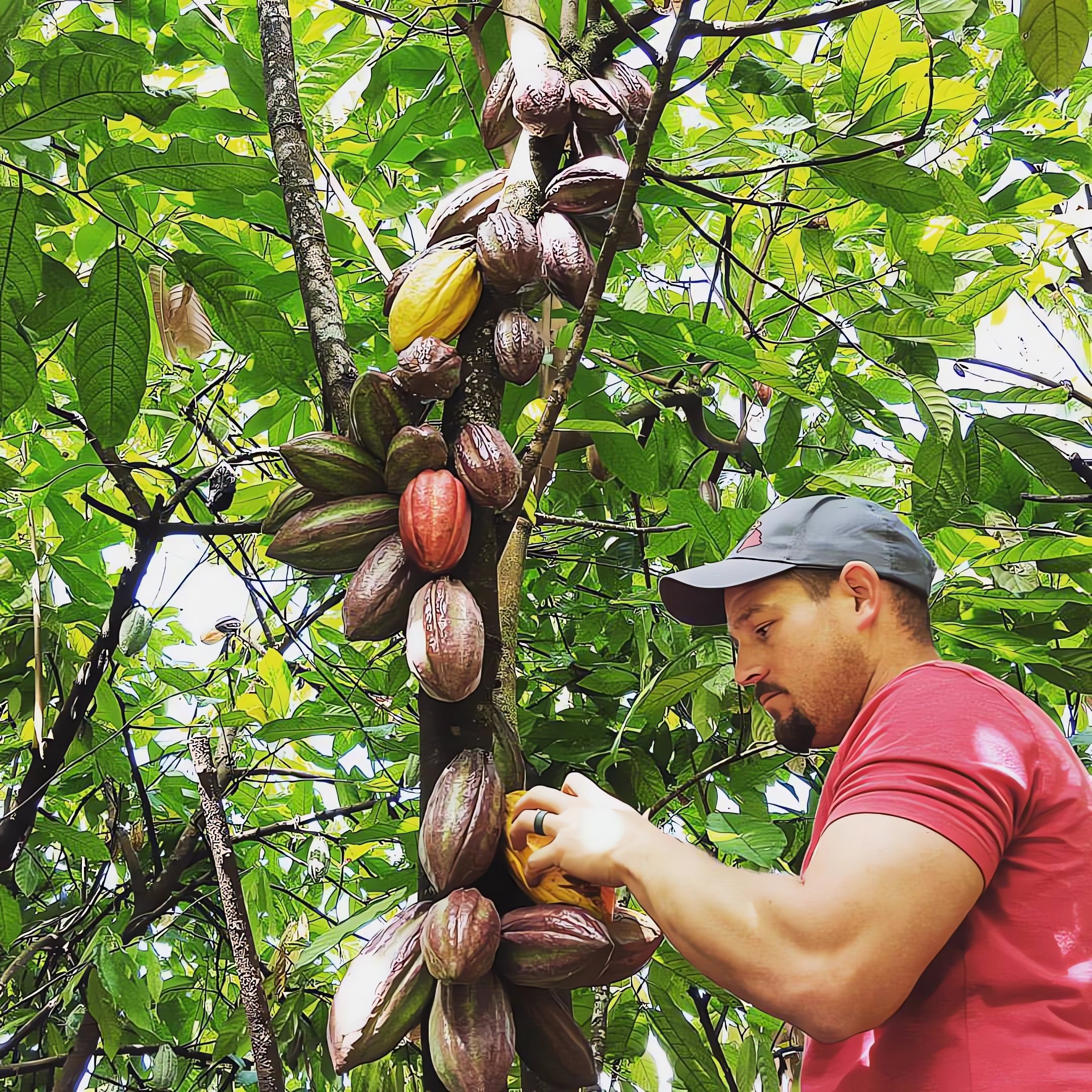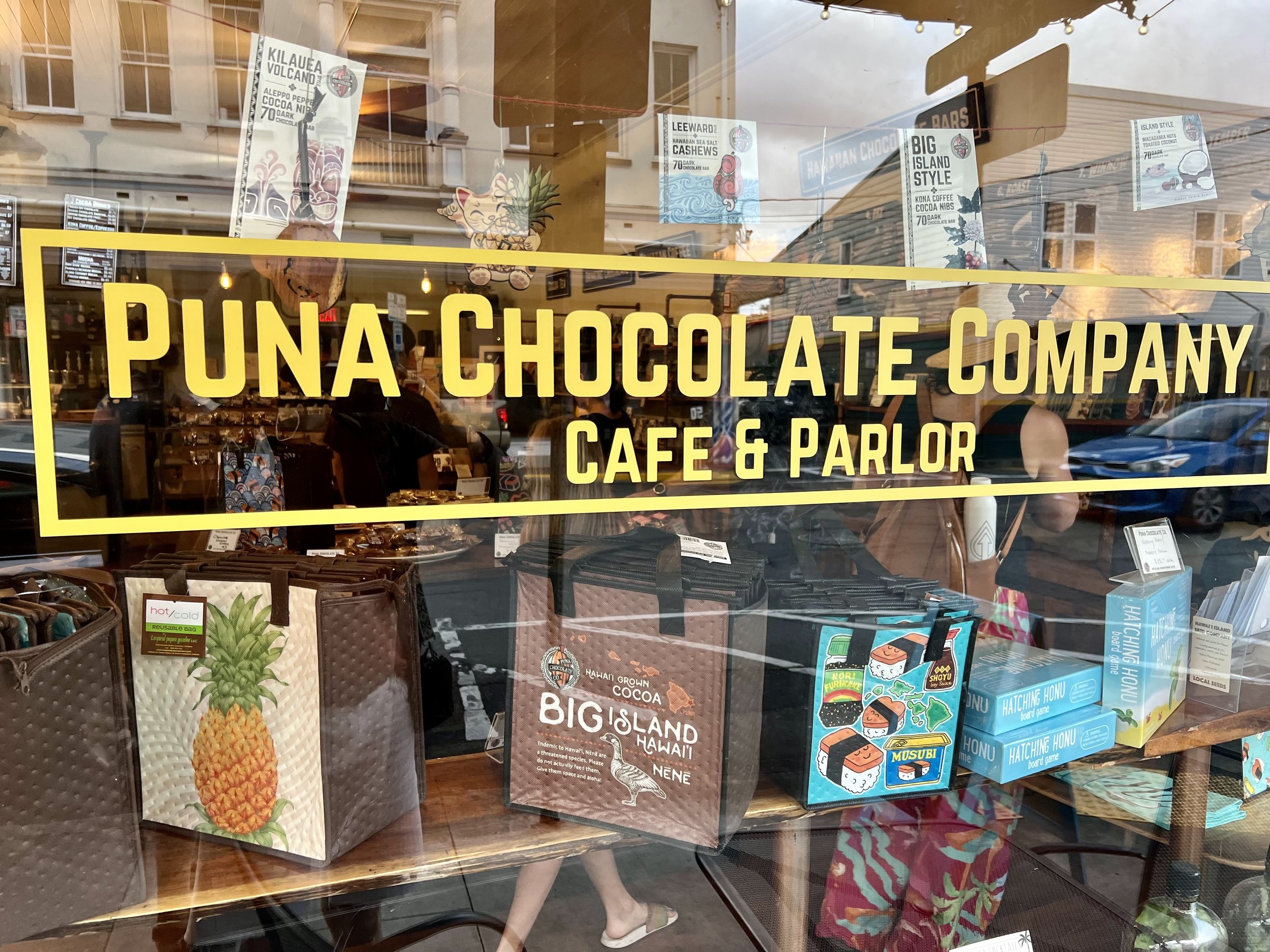How Puna Chocolate Company is Helping Local Farmers & Reforestation in Hawaii
Ben Vanegrtern inspecting cacao tree
Standing under a cacao tree on Hawaii’s Big Island, Benjamin Vanegtern, tropical agriculture expert and co-owner of Puna Chocolate Company, points to a lone tree with red flowers. In a rainforest peppered with mango, banana, and citrus trees, it stands out. “An endangered tree,” Ben says, “and after a volcanic eruption it’s the first plant to take root and grow in a black lava field.” On an island familiar with the threat of volcanic eruptions, the red-flowered ‘ōhi‘a tree is a Hawaiian symbol of resilience. For Puna Chocolate, it’s a fitting symbol of the perseverance and adaptability of the family-owned chocolate company that began with planting a cacao tree 11 years ago on the Big Island of Hawaii.
Protecting the Hawaiian Rainforest
Today, bars of Hawaiian-grown chocolate are selling at a brisk pace in Puna Chocolate Company’s cafes across the Big Island. For Benjamin Vanegtern and Adam Potter, owners of Puna Chocolate, their journey has evolved into something more powerful than chocolate making. What originally began as an environmental mission to preserve the native habitat of their island home grew into a larger purpose. “Working with the land, not against it,” Adam says. Today, through the unexpected vehicle of chocolate, they are behind-the-scenes leaders of tropical conservation and cacao propagation on the largest Hawaiian island.
Curiosity of Cacao
Carefully planting a cacao tree
Ben and Adam had no intention of cultivating cacao when they purchased 65 acres of forested land in 2011. Their goal for the overgrown property was solely land preservation in a pristine region that was experiencing rapid suburban sprawl and environmental disruption. But a random purchase of a fresh cacao pod at a garden stand spurred their interest in growing the local fruit. They learned cacao seedlings thrive among the companionship of taller trees. If done with care, it’s possible to plant a cacao orchard without disrupting the established native trees. So in 2012, Ben and Adam carefully planted their first cacao orchard under the canopy of their Pahoa rainforest.
Lessons in Lava
While waiting for their cacao trees to fruit, Ben, a self-described “Soil Geek”, immersed himself in the Tropical Plants and Soil Sciences program at the University of Hawaii, focusing on cacao cultivation. Meanwhile, Adam and his family practiced chocolate making. But, in late 2014, as preparation began for harvesting their first commercial crop, they were suddenly forced to reevaluate their business strategy. A new, slow-moving eruption from Kīlauea Volcano began advancing toward their Pahoa orchard. The sluggish lava speed of 15 feet/hour allowed the community to prepare for the destructive flow, some even abandoning their homes or businesses, but for 6 months the river of lava surged closer to their crops. This record-breaking Kīlauea flow delivered a clear message to Ben and Adam. For chocolate making to be a sustainable long-term business, Puna Chocolate needed to diversify orchard locations across the island. But, purchasing sufficient land wasn’t feasible due to cost, so instead Puna Chocolate turned to the community.
As the only state in the US where cacao can be grown, Ben and Adam believed their 4,000 square mile island offered acres of untapped potential. Lacking the funds to purchase additional land in the more expensive areas where lava was less likely, Puna Chocolate envisioned a partnership with current landowners. They recognized that cacao could offer residents extra income and help protect the environment via reforestation at the same time. Ideally, Puna Chocolate could be hired to supply the seedlings, assist in managing the orchards, and then buy the raw cacao back for chocolate-making. Both sides have a vested interest in each other succeeding.
Puna Chocolate District chocolate bars
Collecting Diverse Cacao
Puna Chocolate began building a network across the island of new cacao growers, sharing their knowledge of sustainable farm practices. Soon their network of growers began providing a steady supply of cacao for Puna Chocolate. “We collect cacao on the Kona side every other Thursday,” explains Ben, “In Hilo, it’s every 3 weeks. “Puna’s access to cacao across the island also offered an unexpected but treasured gift: Each region on the island (there are 6) produces cacao beans with a distinct flavor. “There’s even a taste difference between winter and summer harvest,” Ben explains. Today, Puna Chocolate’s collection of hand-crafted regional 70% dark chocolate bars called “District Chocolate bars” (one from each microclimate) remains a best seller.
Puna Chocolate Retail
Puna Chocolate Company Cafe & Parlor
Puna Chocolate’s mission was showing results. Ben and Adam began planning for expansion into retail locations, focused on creating community gathering spaces. In 2017, Puna Chocolate opened Puna Chocolate Cafe and Parlor in the heart of downtown Hilo, Hawaii. Six years later, the Hilo cafe continues to thrive as a destination for both local and visiting chocolate lovers.
Chocolate Experiences
In 2018, 90 miles away in Kona, Big Chocolate Island Cafe and Bar opened with a new factory space. Today this bustling 2-story building has a shop, cafe, dessert cocktail bar, and a second-floor gathering space for classes and hands-on chocolate experiences. In 2022, Puna followed with another concept, building a chic wood-paneled speakeasy, The Hidden Nēnē (named after the endangered Hawaiian goose) in Hilo, Hawaii.
Respect for the Land & the People
Puna Cacao Tree Nursery
In a new barista job posted by Puna Chocolate for their newest Hale Cocoa location, “Must love agriculture” is a job requirement. While that may be unusual for a typical barista role, it reflects Puna Chocolate’s values in action. Respecting the island ecosystem is non-negotiable. Local people and responsible farming are valued parts of that ecosystem, and Puna Chocolate’s belief in their community is reflected in their approach to automation. When a question is raised about buying a bar-wrapping machine to increase production speed, Ben’s reply is emphatic “Why buy a packaging machine when instead we can employ more people from the community?” Puna Chocolate prefers creating chocolate in small batches, refusing to upgrade to industrial machinery. “This allows our chocolate makers to express their artisanship while being gentler on preserving the character of each cocoa harvest.” Adam says. “If we use the same machinery as Hershey, we’ll taste like Hershey.”
Today renovations are underway at Puna’s new eco-tourism cacao center in Captain Cook, Hawaii. Indoors will be a cafe, bakery, cocktail bar, and retail shop. Outdoors will be a working cacao and coffee farm showcasing each step in the chocolate making process. The Hale Kokoleka (Hawaiian for House of Chocolate), or the Hale Cocoa for short, is opening in stages starting summer of 2023.
Cacao in the Context of Island Life
In a tropical paradise with four active volcanoes, yearly earthquakes, and seasonal hurricanes with monsoon flooding, the Big Island of Hawaii has many stories to tell—stories about a fragile island ecosystem and the people that live there. For Puna Chocolate, it’s not about the loudest voices. It’s about understanding the volatile nature and risks of island farming while staying true to themselves and making good chocolate. It’s about believing in the power of cacao to tell these stories. Adam says, “Let the bean do the speaking.”





